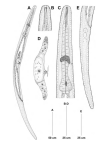 |
Female:
- Small body, 0.29-0.31 mm long, ventrally arcuate after fixation,
tapering at both extremities,
- Cuticle thin, transversely annulated, devoid of somatic setae.
Longitudinal striations absent; lateral fields not visible.
- Lip region low, anteriorly flattened, continuous withbody
contour. Labial and cephalic sensilla inconspicuous
- Amphidial fovea usually indistinct; small elliptical
slit-like, located at 1.4-1.8 lip diameters from anterior end.
- Stoma isomorphic, tubular with indistinct cheilostom, small
gymnostom and long moderately cuticularized stegostom. A relatively
prominent dorsal denticle and two very fine subventral denticles located
at anterior level of tubular stoma.
- Pharyngeal sleeve surrounding stoma at level of denticles.
Pharyngeal corpus cylindrical, ending in a pyriform to triangular basal
bulb with moderately thickened lumen/ valve plates.
- Nerve ring encircling pharynx at 56.3-60.1% of its length from
anterior end. Secretory-excretory pore located at 56.9-66.3% of
pharyngeal length from anterior end.
- Cardia 2-3 mm long. Intestine granular, with thick walls and narrow
lumen. Rectum 0.6-0.8 times abdr long.
- Didelphic, amphidelphic. Ovaries small, outstretched, both on left
or right side of intestine.
- Vulva pre-equatorial, a small slit. Vulva-anus distance 0.8- 1.0
times tail length.
- Tail long, tapering gradually into a hemispherical terminus, without
spinneret or papilla. Caudal glands obscure.
Male:
Ref: Tahseen et al., 2012
|